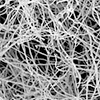| Nov 29, 2022 |
|
(Nanowerk News) Wearable, flexible strain sensors unobtrusively monitor tiny vibrations of human skin in real time and with great accuracy, thanks to innovative fabrication techniques using composite materials. High sensitivity and a wide working range are key parameters for a high-quality strain sensor, but it’s difficult to attain both characteristics on the same sensor due to limitations in structure and conductivity.
|
|
In a recent study in Nano Research (“Ultra-sensitive and wide applicable strain sensor enabled by carbon nanofibers with dual alignment for human machine interfaces”), researchers from Tsinghua University debuted a flexible strain sensor design with a membrane made from stacking parallel and randomly aligned carbon nanofibers (CNF) that achieves both high sensitivity and wide strain detection range.
|
|
Flexible strain sensors have applications in health and activity monitoring, smart textiles and human-machine interaction. The Tsinghua University research team designed a flexible strain sensor for a lip-language recognition system that can help people with damaged vocal cords navigate daily communication.
|
 |
| Scientists from Tsinghua University debuted a flexible strain sensor design that achieves high sensitivity and wide strain detection range based on the design of an integrated membrane containing both of parallel aligned and randomly aligned carbon nanofibers (CNF). The parallel aligned CNF membrane exhibits a low strain detection limit and high sensitivity, while the random aligned CNF membrane exhibits a large strain detection range. (© Nano Research)
|
|
“The lip-language recognition system can directly and quickly translate sentences for people with damaged vocal cords,” said first author Peng Bi from Tsinghua University. “This greatly reduces barriers in everyday communication.”
|
|
To serve this purpose, a flexible sensor needs to be able to collect information from large movements of facial muscles while also distinguishing more subtle changes. “The only way to meet this requirement is to prepare a flexible strain sensor with both high sensitivity and wide strain detection range,” said Bi.
|
|
Unlike conventional sensors made of rigid, bulky metal, flexible sensors can move and conform to human skin without causing discomfort. This class of sensors are typically fabricated of out elastic polymers combined with conductive materials, such as graphene, carbon nanotubes, metal nanoparticles, metal nanowires or liquid metals, which allows them to be integrated into clothing or adhere directly to human skin.
|
|
Up to now, most reported wearable strain sensors showed either large workable strain range or high sensitivity — but not both. Depending on the material, a strain sensor with a large strain detection range can flex or be stretched by over 400%. However, a sensor with a large strain detection range usually exhibits a low gauge factor value, which is an indicator of the sensitivity, and refers to a limited ability to detect minute vibrations under the skin.
|
|
The two advantageous characteristics seemed to be mutually exclusive: in order to achieve high sensitivity, the conductivity of the microstructure sensing layer needs to change significantly when a vibration is detected. Conversely, to achieve wide sensing range, the sensing layer should be continuously conductive, even under large tensile strain. As such, high sensitivity with wide strain detection range appeared to be out of reach, especially for sensors comprised of a single conductive medium.
|
|
Bi and the Tsinghua University team devised a strategy to realize both of the desired features simultaneously.
|
|
When the carbon nanofibers of a membrane are aligned in parallel (p-CNF), the membrane exhibits a low strain detection limit and high sensitivity, whereas a randomly aligned CNF (r-CNF) membrane exhibits a wider strain detection range. By stacking parallel and randomly aligned carbon nanofiber membranes, the researchers realized a flexible strain sensor with high sensitivity and wide strain detection range.
|
|
“Remarkably, the obtained p/r-CNF-based strain sensor showed a strain detection limit as small as 0.005% and an ultra-high gauge factor value of up to 1272 for strains under 0.5%,” said Bi. “At the same time, its maximum strain detection limit is 100%, fulfilling the requirements for detecting most human motions.”
|
|
The team demonstrated that the sensor could accurately distinguish large motions such as joint bending and also detect minor motions such as facial expression, eye rotation, pulse and speaking.
|
|
As proof of concept, they developed an intelligent lip-language recognition system by integrating p/r-CNF strain sensors, Arduino and a loudspeaker. The system can “read lips,” correctly tracking phonetic symbols by interpreting lip movements, and then execute corresponding instructions, such as output lights or audio signals.
|
|
“The recognition system has the potential to help people with language disabilities, proving the potential of this strain sensor in health management and medical assistance,” said Bi.
|
At present, the lip-language recognition system can only cope with limited communication scenarios and locations.
“We will build out application scenarios of the lip-language recognition system, and improve the comfort and portability of wearing,” said Bi. “We hope that such a wearable device can become a second mouth for people with vocal cord damage, and mitigate the effect of this type of injury on someone’s daily life.”
|
|
The dual-alignment structure design of the p/r-CNF strain sensor may also be applied in the design of other high-performance sensors.
|


